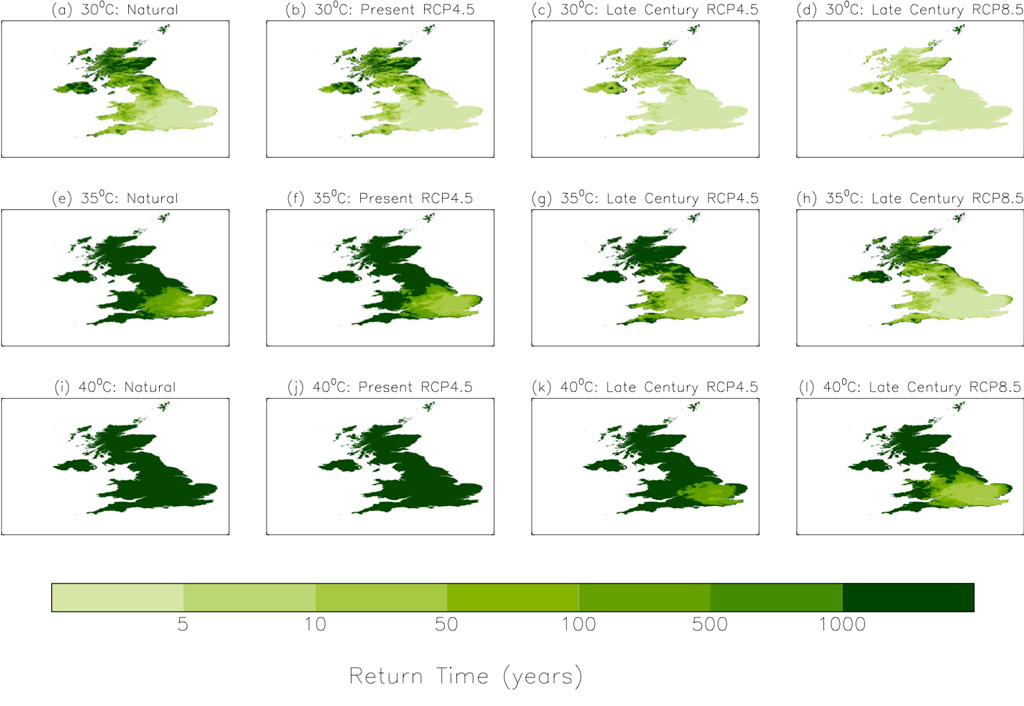
Risk of 40C heat in the UK ‘rapidly increasing’, says Met Office
Daisy Dunne
06.30.20Daisy Dunne
30.06.2020 | 4:00pmThe chances of anywhere in the UK hitting 40C – a temperature not yet recorded in the country – are likely to increase rapidly in the coming decades, a new study finds.
At present, the UK is only expected to see 40C heat once in every 100 to 300 years. But this could rise to every 15 years by 2100 under moderate climate change. In a scenario of very high greenhouse gas emissions, 40C heat could occur every three-and-a-half years.
The research, by the Met Office Hadley Centre, also finds that southeast England is likely to bear the brunt of increasing extreme heat in the coming decades. But, by the end of century, parts of northern England and Wales could also regularly see temperatures of 30-35C.
The next step will be to “understand how the humidity changes along with the temperature, because hot and moist heatwaves can be even harder to cope with”, a climate scientist tells Carbon Brief.
Toast
During last year’s summer heatwave, a new UK-wide temperature record of 38.7C was set in July at the Cambridge University Botanic Garden.
Rapid analysis released the following month found the UK’s record July heat was made 20 times more likely by human-caused climate change.
The record prompted scientists at the Met Office to question whether the UK could one day experience 40C heat – the average summer temperature of the Sahara desert. Dr Nikos Christidis, a senior climate scientist at the Met Office and lead author of the study, which was published in Nature Communications, tells Carbon Brief:
“Exceeding extreme temperature thresholds like 40C in the UK would have severe impacts on public health, transport and infrastructure. Our paper shows that the likelihood of hitting 40C is rapidly increasing. In a ‘natural climate’ without human-caused climate change, the event would have been exceptionally rare, but with climate change the risk is estimated to be up to 10 times higher.”
For the research, the authors explored how the chances of 30C, 35C and 40C heat could change across the UK in the coming decades using climate models.
They investigated rising heat under two scenarios: a “medium” scenario where global greenhouse gases continue to rise before levelling off in the second half of the century (“RCP4.5”) and a “high emissions” scenario where little effort is made to tackle climate change (“RCP8.5”).
They also explored what the chances of extreme heat would have been in the UK in a world without greenhouse gas emissions. (They call this a “natural climate”.)
The researchers made use of a new high-resolution dataset from the Met Office, which allowed them to make projections at the scale of individual towns and cities.
Heating up
The results show that, in the present climate, the UK is expected to hit 40C every 100 to 300 years. In a world without any human-caused climate change, such heat would only be expected every 100 to 1,000 years.
The chances of anywhere in the UK seeing 40C could rise to one in 15 years by the end of the century under the medium emissions scenario and to one in every three-and-a-half years if emissions are extremely high, the study says.
Southeast England “clearly stands out as the region where high temperature extremes are most likely to occur” in the coming decades, the authors say in their research paper.
At present, southeast England is already likely to see temperatures of 30C and 35C, the study says, and it emerges as the region most likely to see 40C heat in the coming decades.
The maps below show chances of 30C (top), 35C (middle) and 40C heat (bottom) across the UK in a world without climate change (far left); the present day (middle left); a 2100 world under medium emissions (middle right); and a 2100 world with high emissions (far right). (Light green indicates a high likelihood, while dark green indicates a low likelihood.)

The chances of 30 (top), 35 (middle) and 40C heat (bottom) for a model scenario without climate change (far left); present day (middle left); a 2100 scenario under moderate climate change (middle right) and a 2100 scenario with extreme climate change (far right). (Light green indicates a high likelihood, while dark green indicates a low likelihood.). Credit: Christidis et al. (2020)
Southeast England is likely to bear the brunt of increasing heat because of its geography, explains Christidis.
The region is close to continental Europe – meaning it is more likely to be affected by heatwaves moving in from warmer European countries – and far from the typical path of Atlantic storms, which bring cold and cloudy weather. He adds:
“Scotland and the north of England have a less continental climate that is more strongly moderated by the ocean and, hence, these regions are cooler and less susceptible to hot extremes.”
The researchers also investigated how the chances of extreme heat are changing in the capital.
The results show that London is two to three times more likely to see temperatures above 35C at present than it would have been in a world without climate change.
By the end of the century, London is expected to see temperatures above 35C at least twice a decade under medium emissions. Under high emissions, the capital could see 40C heat every decade or so, the authors add.
‘Concerning’
The findings are “concerning”, says Prof Dann Mitchell, head of the Climate Dynamics Group at the University of Bristol, who was not involved in the study. He tells Carbon Brief:
“The change in risk ratios with 40C looks to be more uncertain compared to the conclusions for 35C and 30C. Nevertheless, for a medium emissions scenario, summers which see above 40C degrees will change from a 1-in-300 year return period, to a 1-in-11 year return period for certain locations in the UK. It will be important to understand how the humidity changes along with the temperature because hot and moist heatwaves can be even harder to cope with.”
The results should help policymakers in UK towns and cities to plan for the impact of extreme heat on health services, adds Dr Eunice Lo, a researcher of climate extremes and health, also from the University of Bristol. She tells Carbon Brief:
“High temperatures have direct impacts on human mortality and these impacts vary from location to location depending on its demography, so high-resolution analyses like this are useful for future planning in terms of protecting health from extreme heat.”
Christidis, N. et al. (2020) The increasing likelihood of temperatures above 30 to 40C in the United Kingdom, Nature Communications, https://www.nature.com/articles/s41467-020-16834-0
-
Risk of 40C heat in the UK ‘rapidly increasing’, says Met Office
-
UK could see 40C heat at least ‘every 15 years’ by 2100, says Met Office

